Celestron debuts its first smart telescope, the Celestron Origin Intelligent Home Observatory, priced at $3999. Equipped with a 6″ RASA Telescope at f/2.2 on a Nexstar Evolution mount, it targets the premium segment of the smart telescope market. Operated through the Celestron Origin APP over WiFi, this telescope will be the fastest light-gathering smart telescope in 2024. How does the Celestron Origin compare against other high-end smart telescopes? Let’s find out in this preview. The year 2024 promises exciting developments in the realm of smart telescopes!
Smart Telescopes: From Pioneering Innovators to Established Players
The world of smart telescopes is experiencing a surge in popularity, offering an exciting alternative for those who crave the gaze at the wonders of the night sky without having to learn the complexities of astrophotography. Imagine setting up a telescope effortlessly, powering it on, and letting it automatically discover, track, and capture celestial objects in the night sky. Pioneering companies like Unistellar (Equinox, EVscope), Vaonis (Stellina, Vespera), and Dwarflab (Dwarf II) were among the trailblazers in releasing smart telescopes. Now, even established names in the astrophotography community, such as ZWO and Celestron, are making their mark in this dynamic field.
What makes this even more thrilling is the diverse approach taken by different brands. ZWO provides an affordable and enhanced stargazing experience with the Seestar S50, priced at $500. On the flip side, Celestron boldly ventures into the high-end spectrum of the smart telescope market with the Celestron Origin Intelligent Home Observatory, retailing at $3999. How does it stack up against other high-end smart telescopes? Let’s explore this further…

The Celestron Origin Intelligent Home Observatory is available as a pre-order at Agena Astro (USA/WW), High Point Scientific (USA/WW), and Astroshop (EU/WW).
Celestron Origin telescope optics: Aperture, Focal length, and f/ratio
Let’s dive into the details of the optical design first. This Celestron Origin Intelligent Home Observatory features a 6″ Rowe-Ackermann Schmidt Astrograph (RASA) telescope. The stand-alone RASA telescopes are among the most popular telescopes in the amateur astrophotography community today, due to their “speed” and large apertures.
In astrophotography, aperture refers to the diameter of the telescope’s mirror or lens. A larger aperture is crucial for capturing more light when imaging faint celestial objects. With its 6″ aperture (152mm), the Celestron Origin outperforms other smart telescopes in this high-end price range, such as Unistellar’s EVscope 2 with an aperture of 114mm, or the Vaonis Stellina with an 80mm aperture.
The Celestron Origin has a focal length of 335mm. The focal length refers to the distance from the mirror or lens of the smart telescope to the camera sensor. At 335mm, the focal length is slightly shorter than that of other high-end smart telescopes like the EVscope 2 and Equinox 2, both having a focal length of 450mm, and the Vaonis Stellina at 400 mm. A larger or smaller focal length is not necessarily good or bad in itself, but depends on the size of the object in the night sky you want to photograph. We’ll discuss that further when looking at the field of view of this telescope.
The f/ratio of the Celestron Origin is an incredibly fast f/2.2 – which represents the focal length divided by the aperture. A faster f/ratio is favorable as it permits more light to reach the camera sensor in a shorter time. The f/ratio of the Celestron Origin is much “faster” compared to other smart telescopes on the market, varying between f/4 and f/5. This, in turn, facilitates quicker exposure times for capturing subtle celestial details of deep-sky objects with a camera.
However, it’s important to note that for luminous solar system bodies like our Moon and the planets, a higher f/ratio and a longer focal length tend to be more advantageous. Celestron also offers high-quality telescopes for planetary imaging.
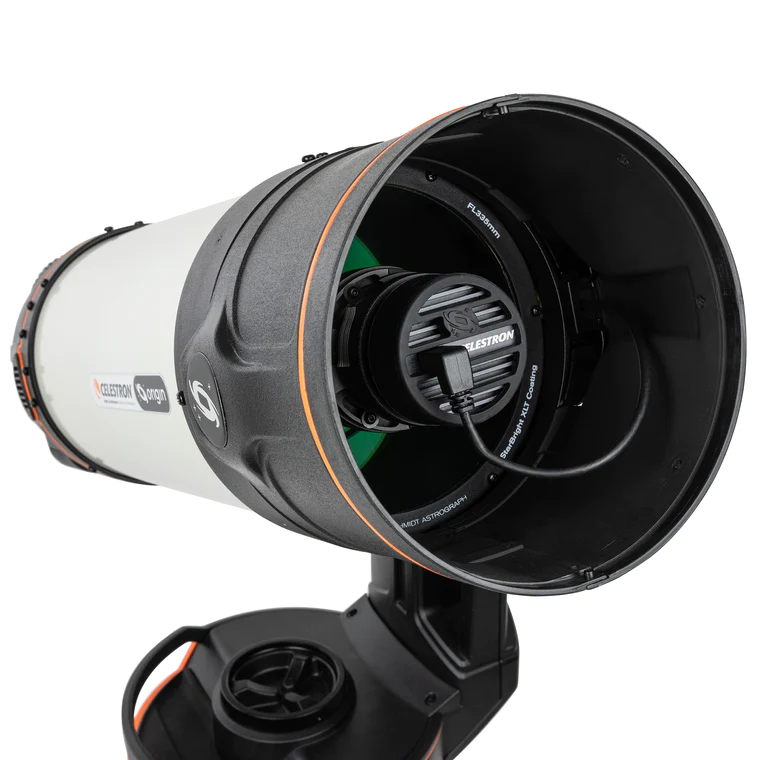
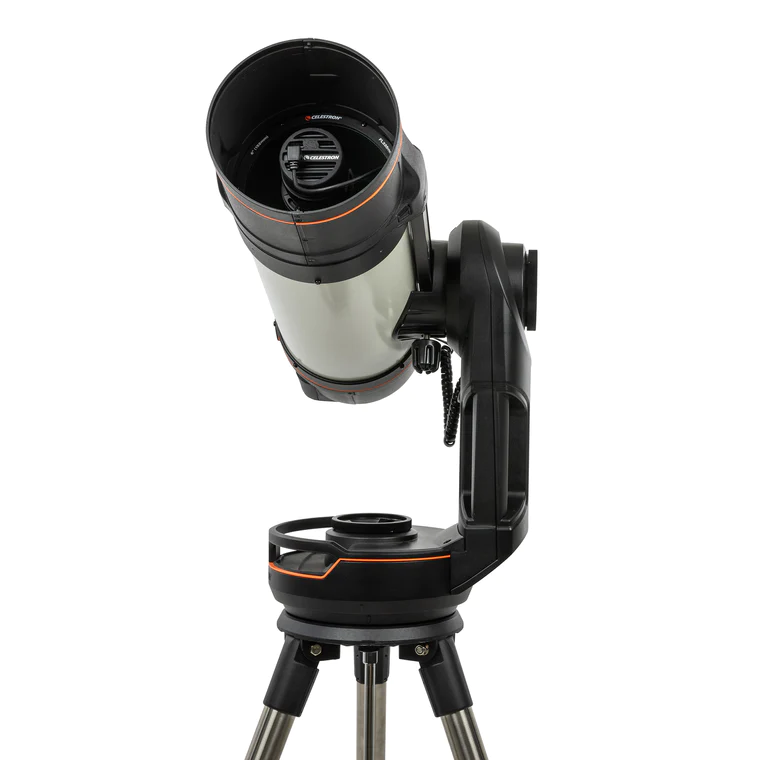
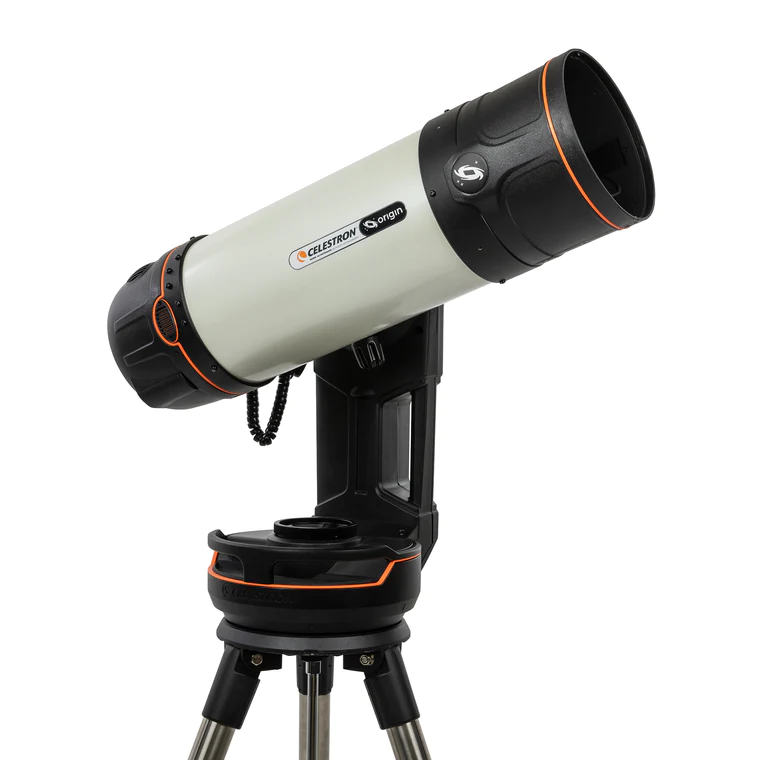


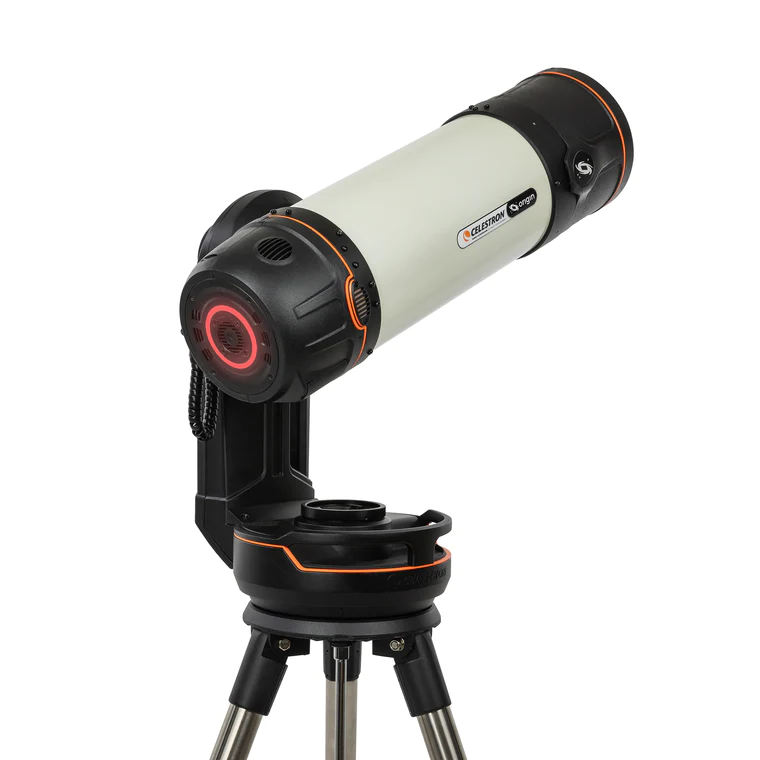
Celestron Origin: Resolution, Image Scale, and Field of View
Camera Resolution
Celestron chose to include the Sony STARVIS IMX178 color camera in the Celestron Origin, which is not the newest camera sensor. This same sensor is also present in the Vaonis Stellina, which was released back in 2018. I purchased a ZWO camera equipped with the IMX178 sensor (the ASI178MC) myself approximately five years ago, and you can still find my review on both my YouTube channel and website. At the time of the review, my main takeaway was that it served as an excellent camera for short exposures but was less suitable for capturing longer exposure images due to amp glow, particularly towards the top right of the image.
Since then, Sony has introduced more advanced STARVIS 2 camera sensors that effectively address the amp glow issue. However, considering the relatively short exposures with the RASA 6″, amp glow may not pose a significant problem. Additionally, the Celestron Origin APP could potentially integrate a feature to address amp glow by subtracting dark frames.
The IMX178 camera sensor in the Celestron Origin offers a resolution of 6.4 MegaPixels (3096×2080) which is nice, but not the largest sensor. In comparison, the Vaonis Stellina smart telescope features the same sensor, while Unistellar’s EVscope 2 showcases a more advanced IMX347 sensor with an impressive 7.7 MP. The soon-to-be-released Vaonis Vespera Pro, scheduled for May 2024, takes it a step further with an IMX676 STARVIS 2 sensor boasting an impressive 12.5 MP (3536 x 3536). For my complete overview of smart telescopes, check this blog.
Importantly, and this is exciting, the camera sensor is in front of the telescope in the RASA design, and Celestron made it “user accessible” so it may be possible to upgrade the Celestron Origin to a newer camera sensor in the future. This being said, I’d love to have seen a newer STARVIS 2 sensor incorporated from the start, especially at this high-end price range.
Image Scale
Image scale, measured in arc seconds, is a unit of angular measurement in astronomy. It quantifies the apparent size of celestial objects. For example, the average apparent size of the Moon, as seen from Earth, is 0.5 degrees, which equals 30 arc minutes, or 1,800 arc seconds. Put differently, 1 degree of the sky equals 60 arc minutes, and 3,600 arc seconds.
A low image scale – defined as arc seconds per pixel – offers a more detailed view, vital for capturing intricate features of celestial objects. However, stars may appear very large, or ‘bloated’ in your pictures. A high image scale is also not favorable, as it causes stars and celestial objects to cover only a few pixels, appearing blocky. A general rule of thumb is to have an image scale between 1 and 2 arc seconds per pixel for an optimal view, and the Celestron Origin falls exactly within that range!
The image scale of the Celestron Origin is 1.45 arc seconds per pixel, whereas both Unistellar’s EVscope 2 and Equinox 2 achieve a more detailed image scale at 0.66 arc seconds. The Vaonis Stellina achieves 1.24 arc seconds, while the upcoming Vaonis Vespera Pro will boast 1.60 arc seconds per pixel.
Field of View
The field of view – measured in degrees – represents the portion of the sky visible in a single image. A wider field of view is advantageous for capturing expansive nebulae or star clusters, while a narrower field is suitable for detailed shots of smaller celestial objects, such as distant galaxies. For example, one of the largest apparent objects in the night sky is our neighboring Andromeda Galaxy, which covers roughly 3 by 1 degrees in our night sky. In contrast, galaxies such as the Whirlpool Galaxy only cover about 11×7 arc minutes (i.e., 11/60th by 7/60th of a degree).
The Celestron Origin boasts a field of view of 1.27° x 0.85°. In this premium price range, the Vaonis Vespera Pro will offer a slightly larger FoV of 1.6° x 1.6°, the Vaonis Stellina covers 1° x 0.7°, and both the Unistellar EVscope 2 and the Equinox 2 have the smallest field of view in the night sky, at 0.34° x 0.45° – just enough space to encompass the full moon!
Importantly, the Vaonis Smart Telescopes can capture panorama pictures of the night sky, up to 4 times the native field of view of the camera sensor. This technique known as covaLENS, is not yet found in other smart telescope APPs. It would be fantastic if Celestron would be able to develop a comparable feature into the Celestron Origin APP! However, as this feature is not mentioned by Celestron, this is probably not (yet) the case.
The images below provide a representation of the approximate native field of views achievable with the Celestron Origin. As depicted, the Andromeda Galaxy (M31) will not entirely fit within the field of view, the Orion Nebula (M42) will be well-framed when centered, and the Whirlpool Galaxy (M51) will appear as a small object in the FoV of the Celestron Origin. Calculations were made using astronomy.tools.

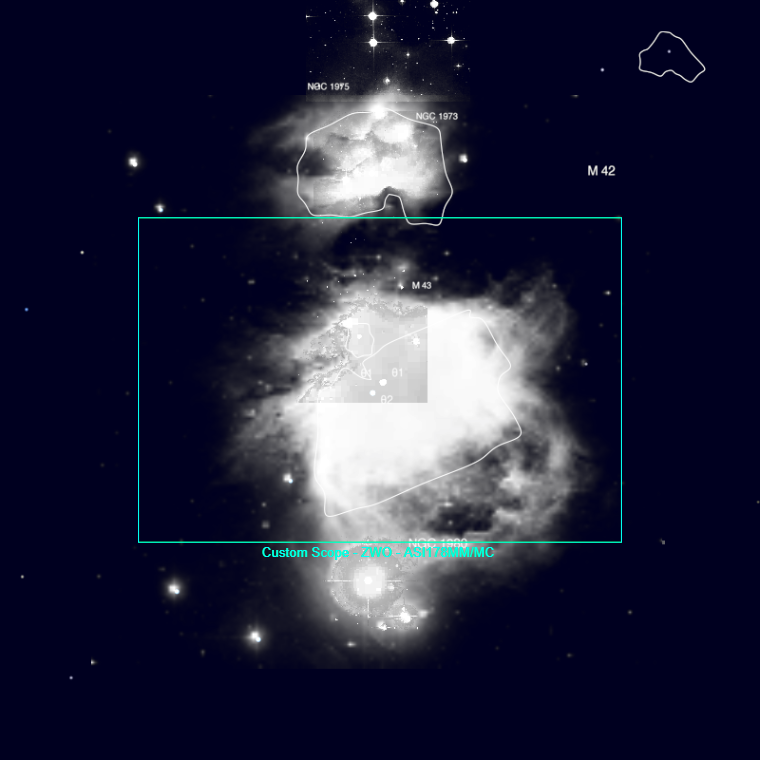

Celestron Origin on a Nexstar Evolution Mount
The Celestron Origin is mounted on a Nexstar Evolution mount, specifically an altitude-azimuth mount. As of now, all smart telescopes employ an alt-az mount, allowing for automatic discovery, tracking, and photographing of celestial objects without the need for manual steps like polar alignment. However, a drawback of alt-az mounts is their limited tracking precision, attributed to not accounting for Earth’s tilt. This limitation imposes a maximum exposure limit to prevent star elongation.
Additionally, smart telescopes are susceptible to ‘field rotation,’ leading to the apparent rotation of celestial objects during tracking. Although stacking algorithms can help alleviate this issue, distortions, particularly at the image edges, are present in multiple smart telescopes I tested. Despite these limitations, smart telescopes significantly enhance the stargazing experience by providing a convenient way to observe celestial wonders without requiring extensive astrophotography knowledge.
Crucially, Celestron hints on their website about the forthcoming availability of an optional wedge upgrade for the Celestron Origin. This is highly probable, given that a wedge for the Nexstar Evolution mount is already offered for other “non-smart” telescopes by Celestron. This is truly exciting, because of the following: With the inclusion of this wedge – and potentially the StarSense AutoGuider (guide scope) – the mount could achieve polar alignment, enabling more precise tracking of the night sky and the possibility of capturing longer exposure images. This upgrade would largely mitigate the field rotation issue and enhance the quality of your astrophotos by taking longer exposure pictures, vastly improving the signal-to-noise ratio. This prospect is undeniably thrilling!
Celestron Origin APP
A well-designed, reliable, and user-friendly app is essential for any smart telescope’s effective control. I’ve encountered challenges in the past, including failed WiFi connections, poorly designed interfaces, and calibration failures. Celestron aims to deliver a high-quality app named “Celestron Origin,” featuring their proven StarSense technology. My cautious optimism stems from previous positive experiences with Celestron software, which has consistently proven to be reliable and easy to use.
Similar to other smart telescopes, the Celestron Origin needs to be placed outdoors, powered on, and connected over WiFi to the app. You can then choose to stay by your telescope or head indoors. Celestron promises that in under two minutes, Origin autonomously focuses, scans the night sky, aligns itself by matching star patterns to its internal database, and notifies you that it’s prepared for your astronomical journey.
The Celestron Origin app, developed in collaboration with Simulation Curriculum, the creators of SkySafari™, will feature an intuitive planetarium interface that simplifies navigation through the night sky. Utilizing the planetarium view, you can hold your device up to the sky for a 360-degree “compass mode” exploration, and tap on any object you wish to observe (highlighted for your convenience). Alternatively, explore Tonight’s Best list, where Origin showcases the most remarkable galaxies, nebulae, star clusters, and more—tailored to your exact location and observing time. Forget about consulting star charts or planning; Origin is ready to unveil the universe whenever you are.
Once you’ve selected a target, Origin precisely centers it in the field of view. Switch to the camera view, press Start Imaging, and begin capturing 10-second exposures. It’s as simple as that! Witness the real-time results as the target reveals more intricate details. As Origin operates, it continuously tracks the sky and adjusts its integrated dew prevention system to ensure your images remain sharp. Multiple users can use the Origin app to view the telescope’s live feed simultaneously. You can also cast the view to your smart TV or save and share it instantly.
These aspects seem promising, and it will be intriguing to assess whether the Celestron Origin app can equal or even exceed the quality offered by the Singularity app from Vaonis, the Seestar app from ZWO, and/or the Unistellar app used to control the smart telescopes currently available in the astronomy market. Here are some pictures of the Origin APP, released by Celestron.
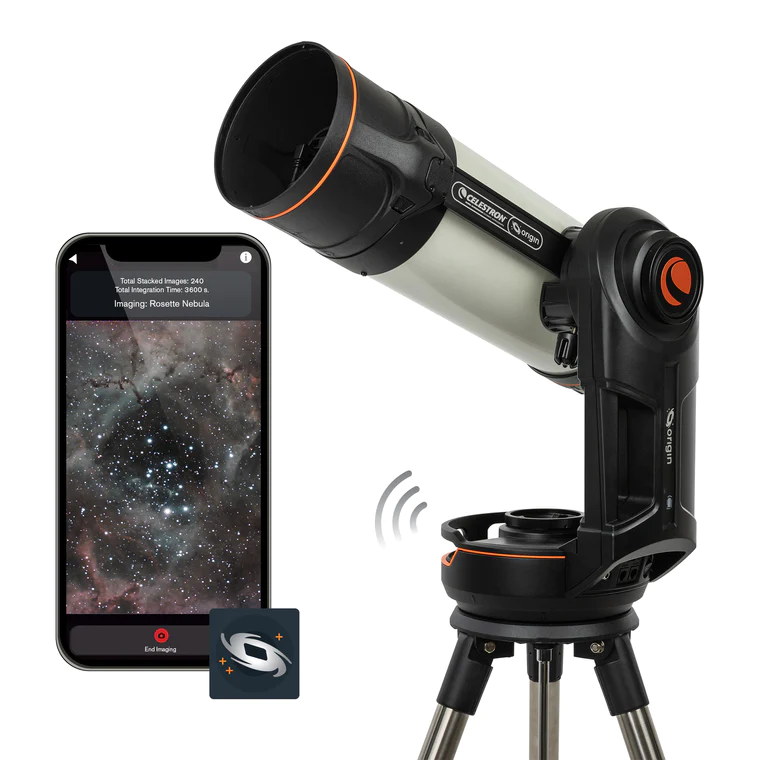


Image Quality of the Celestron Origin
Celestron has unveiled a couple of exciting images, captured by its Celestron Origin Intelligent Home Observatory. Regrettably, there is currently no exact information available regarding the formats of these pictures. The download options will probably align with the file formats commonly used by other smart telescopes. This may include the choice to instantly share jpg images, downloading RAW fits files for manual processing, and 16 bit TIFF files of the stacked pictures. However, these details are yet to be confirmed.
Additionally, there is no mention of (RAW) video options (MP4, AVI) for capturing footage of the Moon or the Sun – a feature that is present in other smart telescope APPs like ZWO’s Seestar APP. Such a feature would enable exciting options like taking LIVE videos of lunar and solar eclipses.
If you’re interested in comparing these images with those from other smart telescopes, please check out my Best Buy guide on smart telescopes. In that guide, I share images I captured with other smart telescopes in my urban backyard (Bortle 6/7), offering a comprehensive overview of available smart telescopes and their features.

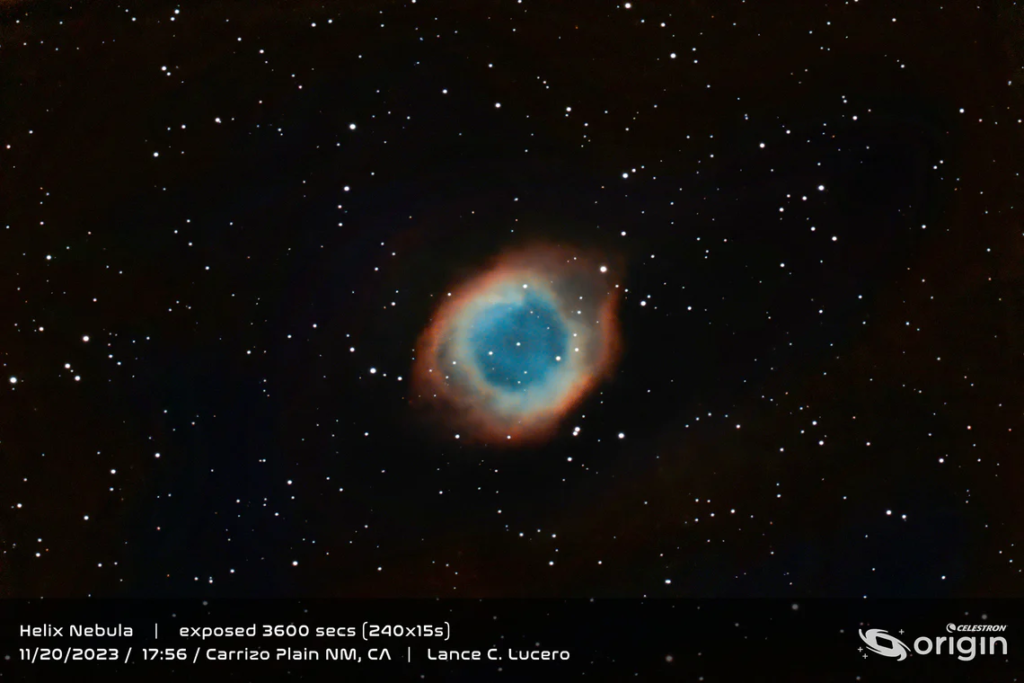
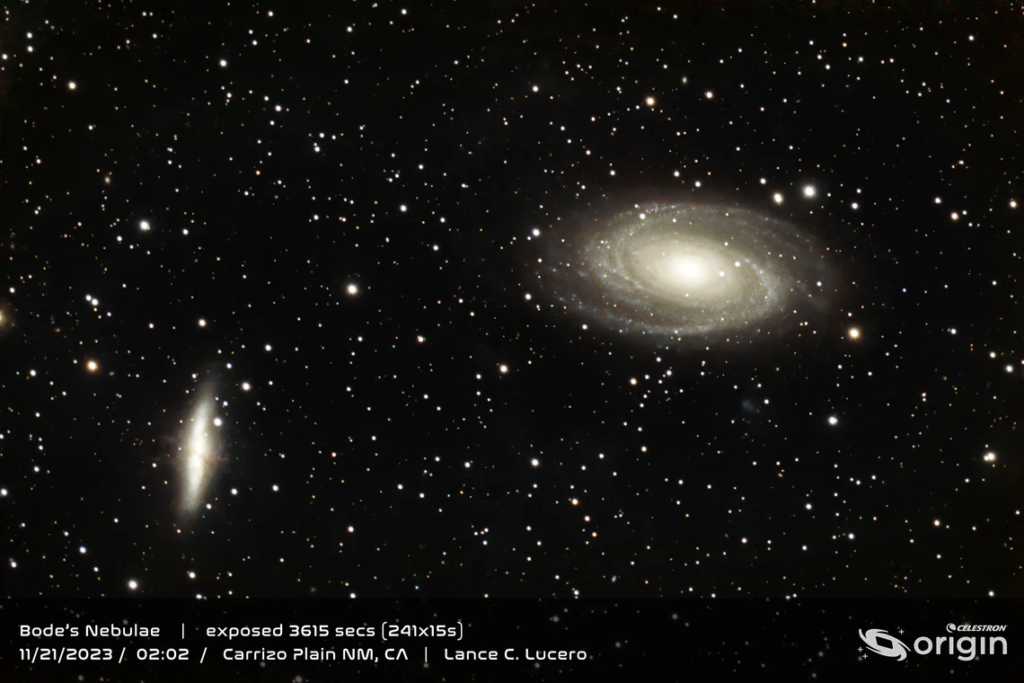
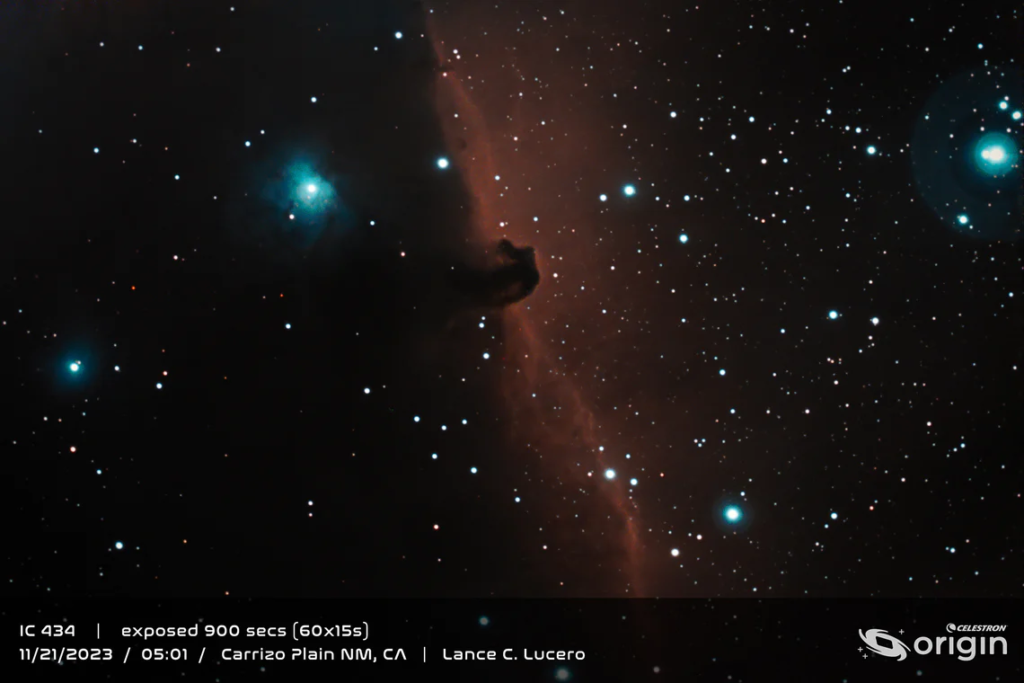
Battery Life and Storage Capacity
The Celestron Origin comes equipped with an Integrated LiFePO4 battery, offering a usage time of over 6 hours. While this duration seems sufficient for a night of stargazing, it falls short of the 10-hour battery capacity of Unistellar’s EVscope 2 and Equinox 2, as well as the promised 11-hour capacity of the upcoming Vaonis Vespera Pro set to be released in May.
Currently, it remains unclear what the storage capacity for storing images will be. Many contemporary smart telescopes typically feature a 64GB storage capacity (such as Unistellar EVscope 2 and Equinox 2), with the Vaonis Vespera Pro boasting an even larger 225GB SD card. Let’s hope for the best!
Weight and Size
The weight of this smart telescope may be its Achilles heel. The Celestron Origin has a total weight of 18.87 kg (41.6 lbs), comprising the telescope at 4.8 kg, the mount at 7.7 kg, and the tripod at 6.35 kg. This positions the Celestron Origin as one of the heaviest smart telescopes available, contrasting with the Vaonis Stellina at 11 kg, Unistellar’s EVscope 2 and Equinox 2 at 9 kg, and the Vaonis Vespera Pro at 5 kg. Not exactly a telescope you can put in your backpack for a hiking trip.
In terms of dimensions, the fully assembled system measures 61 x 66 x 122 cm (L x W x H), rendering it more voluminous compared to other smart telescopes in the market. Notably, Unistellar’s EVscope 2 has dimensions of 77 x 33 x 26 cm, Equinox 2 at 65 x 23 x 12 cm, Vaonis Stellina at 49 x 39 x 13 cm, and the Vaonis Vespera Pro at 48 x 20 x 9 cm.
Astrophotography filters
The Celestron Origin is equipped with a built-in filter drawer designed to accommodate standard 1.25” and 2” format filters. This feature enables you to incorporate optional filters, proving particularly advantageous when imaging nebulae in light-polluted settings such as a typical suburban backyard. To capture broadband objects like galaxies and star clusters in dark-sky environments, you can easily remove the filter to enhance light throughput, resulting in brighter images.
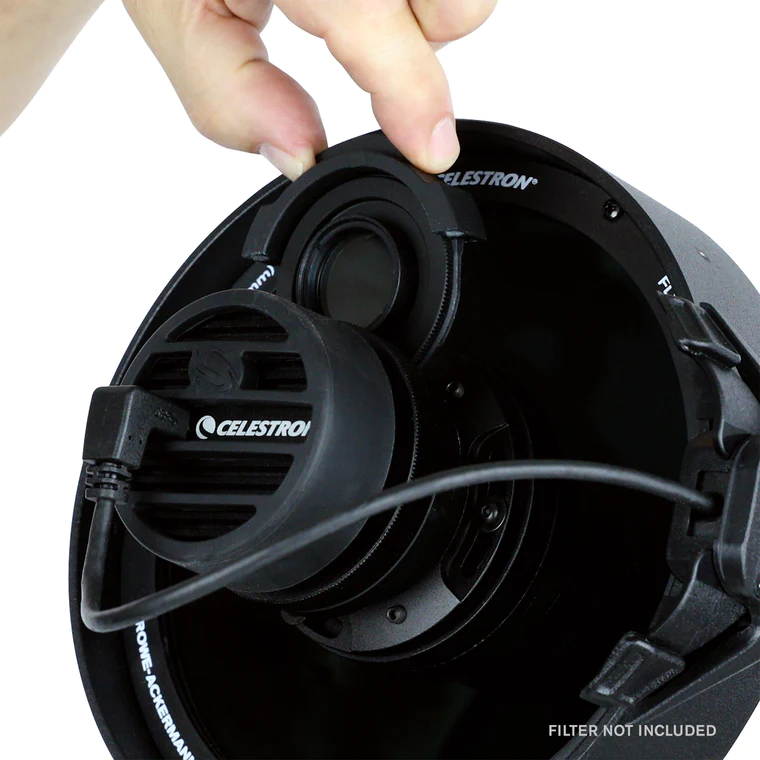
In conclusion
The Celestron Origin Intelligent Home Observatory stands out as a highly anticipated addition to the upper echelon of smart telescopes. Noteworthy features include the 6″ RASA optical design at f/2.2, making it the fastest light-gathering smart telescope in the astromarket for 2024! Another enticing aspect is the future potential to enhance the Celestron Origin with a wedge and auto-guiding option, facilitating more precise tracking of the night sky and enabling longer exposure, and higher-quality pictures with an improved signal-to-noise ratio.
However, it’s not without its imperfections. In this high-end price range, a more recent Sony IMX STARVIS 2 sensor would be preferable compared to the five-year-old IMX178. Additionally, the telescope’s considerable weight and size set it apart from more portable high-end telescopes available in the current astromarket. Moreover, it will be interesting to see if this premium-priced smart telescope is preferred over ‘less smart’, but more capable amateur astrophotography setups.. Is the future smart? Let’s wait and see!